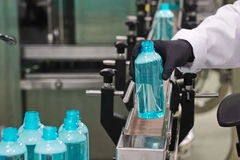Amazon utilizes machine learning and automation for made-to-fit packs in Europe
Amazon is deploying advanced automated packing technology in Europe through custom-box making to improve regional operations and reduce waste. Made-to-fit packaging can reduce delivery emissions by minimizing materias, eliminating waste, and maximizing vehicle space.
The e-commerce giant plans to install hundreds of automated packaging machines across its European fulfillment centers to limit packaging volumes for millions of customer deliveries. Amazon says that most of these machines will be installed in Germany, the UK, France, Italy, and Spain by the end of this year.
“To reduce waste, we need to reduce packaging. We use machine learning and automation to create packaging that’s made to fit, reducing excess materials while making sure the product remains protected,” says Pat Lindner, vice president for Mechatronics and Sustainable Packaging at Amazon.
“We’re now installing automated packaging machines in our facilities across Europe to better serve our customers and the planet. This investment is a significant step forward in reducing the environmental impact of deliveries for our European customers.”
Made-to-measure tech
Amazon aims to match the packaging to the product through its made-to-measure technology. This entails custom-made cardboard boxes created in real time, on-demand made-to-fit paper bags, and innovative labeling technology.
 Amazon applies made-to-measure tech to optimize material usage and customization.Through automation and precise sizing technology, employees place an item into the machine, which uses sensors to measure its dimensions and automatically produce a box that is made to fit, reducing excess packaging material.
Amazon applies made-to-measure tech to optimize material usage and customization.Through automation and precise sizing technology, employees place an item into the machine, which uses sensors to measure its dimensions and automatically produce a box that is made to fit, reducing excess packaging material.
The machine applies shipping labels directly, making each package ready for immediate dispatch to customers. The technology will be used to pack heavy or fragile items that need more protection than a padded envelope provides.
Furthermore, Amazon’s packaging engineers reimagined a machine originally used to create plastic bags and retrofitted it to cut made-to-fit paper bags. Sensors measure an order’s dimensions, and then the new device creates a correctly sized, protective bag using a durable, weather-resistant paper and heat-sealing technology.
Amazon says the technology was tested in fulfillment centers in Germany and the UK, and will now roll out across both countries, as well as France, Italy, and Spain. By packing items in light paper packaging, without the need for padding, the machines reportedly help to avoid more than 26 g of packaging per shipment, on average. Amazon says its lightweight paper bags are up to 90% lighter than similar-sized cardboard boxes.
Meanwhile, the e-commerce company uses the Universal Robotic Labeller, which is a high-speed auto-labeling machine that can place smaller labels onto packages, including irregularly shaped items. It can use labels up to 75% smaller than standard labels, helping to reduce packaging dimensions and using less material overall.
The labels can also be placed onto paper bags, or directly onto items that ship in their own product packaging. This eliminates the need for additional Amazon packaging altogether and contributes to reduced waste for the customer.












